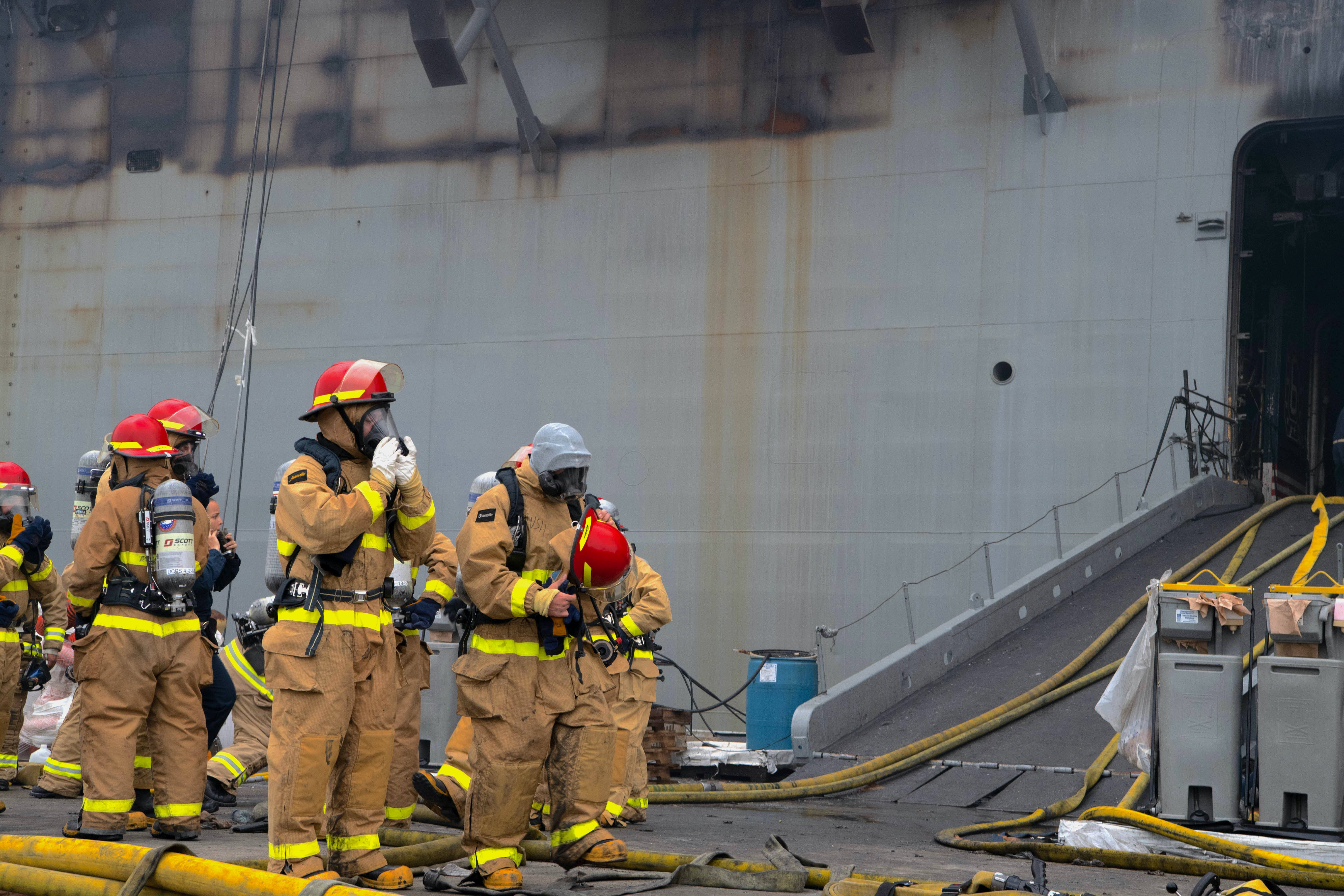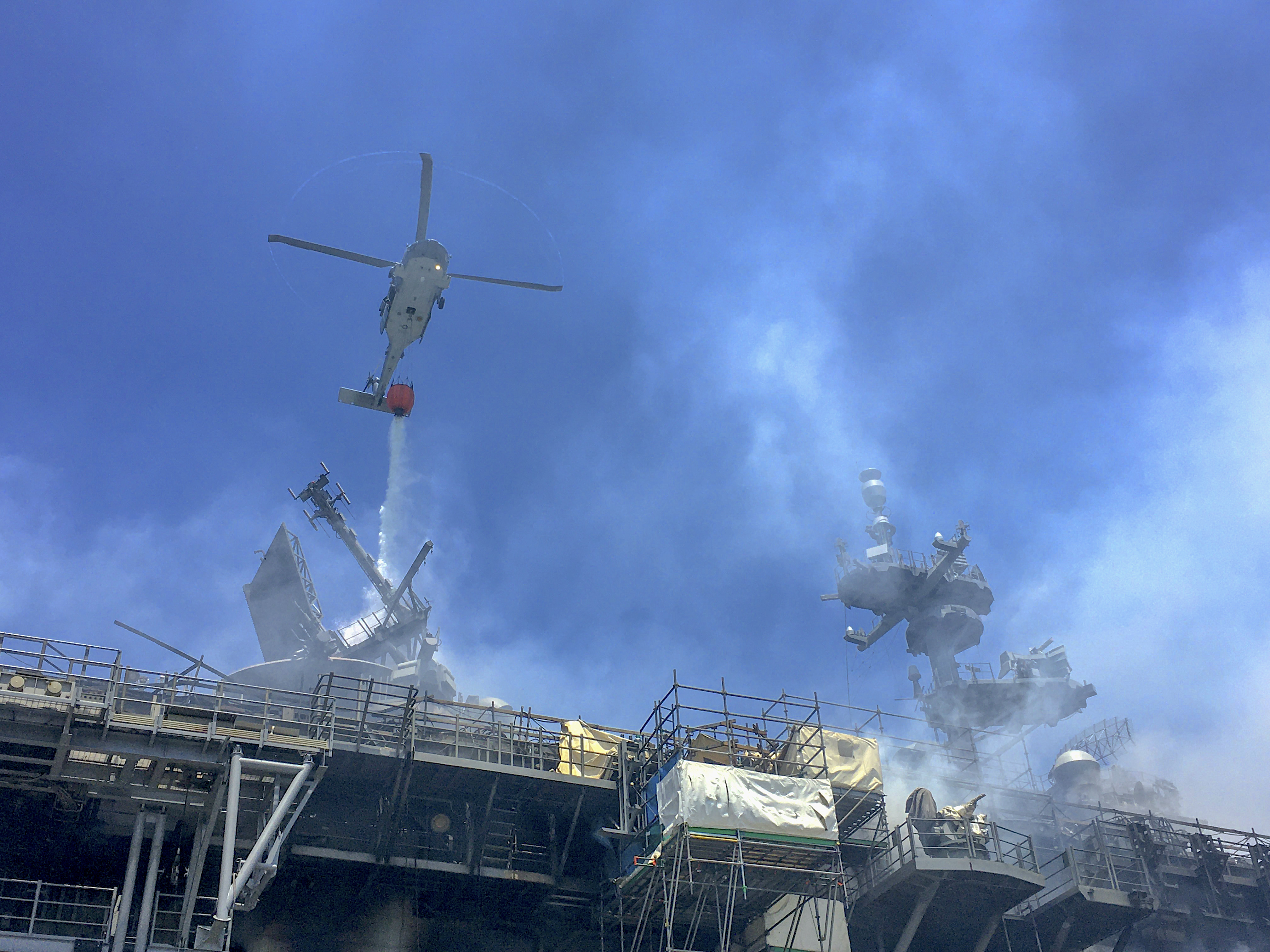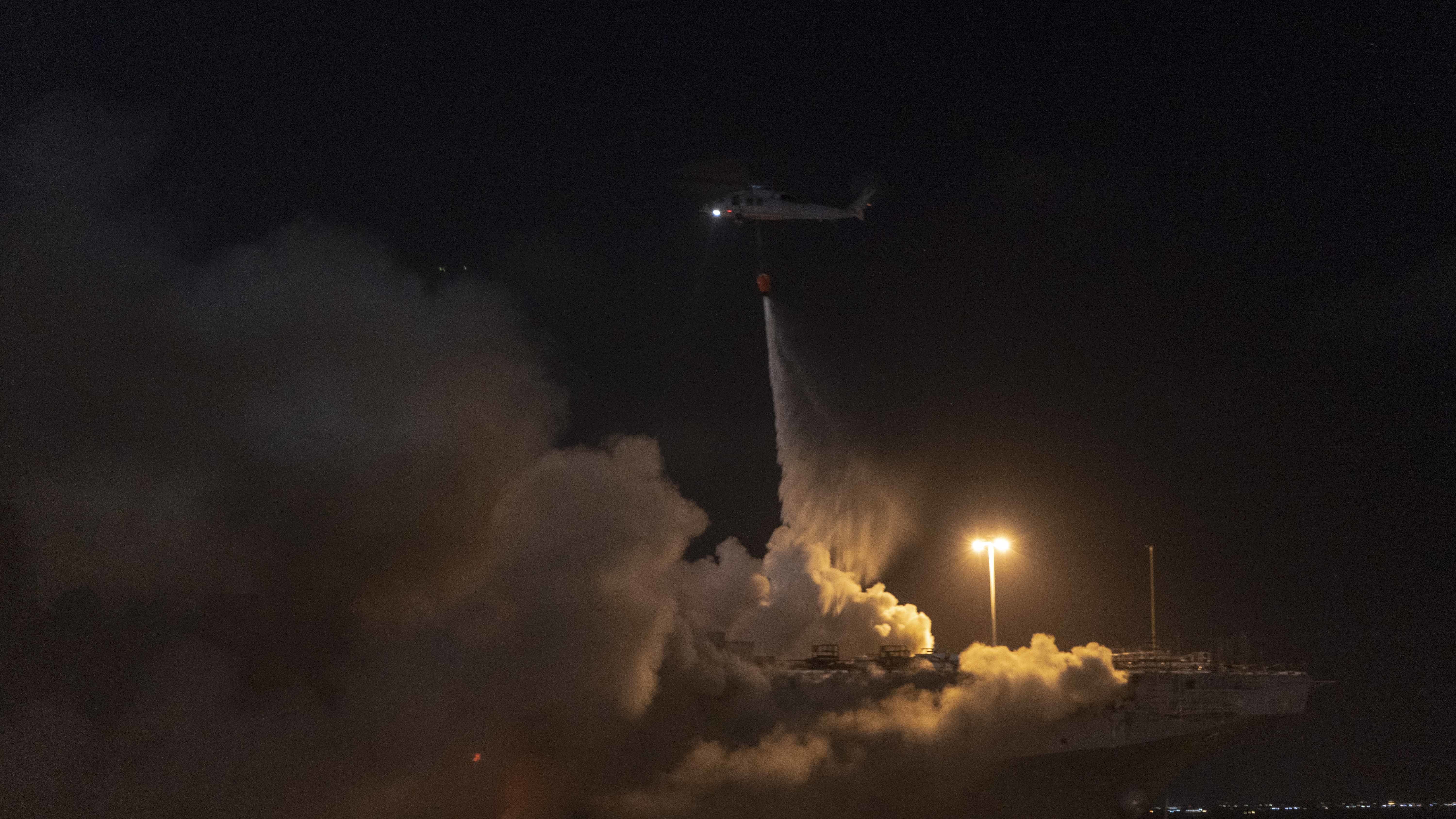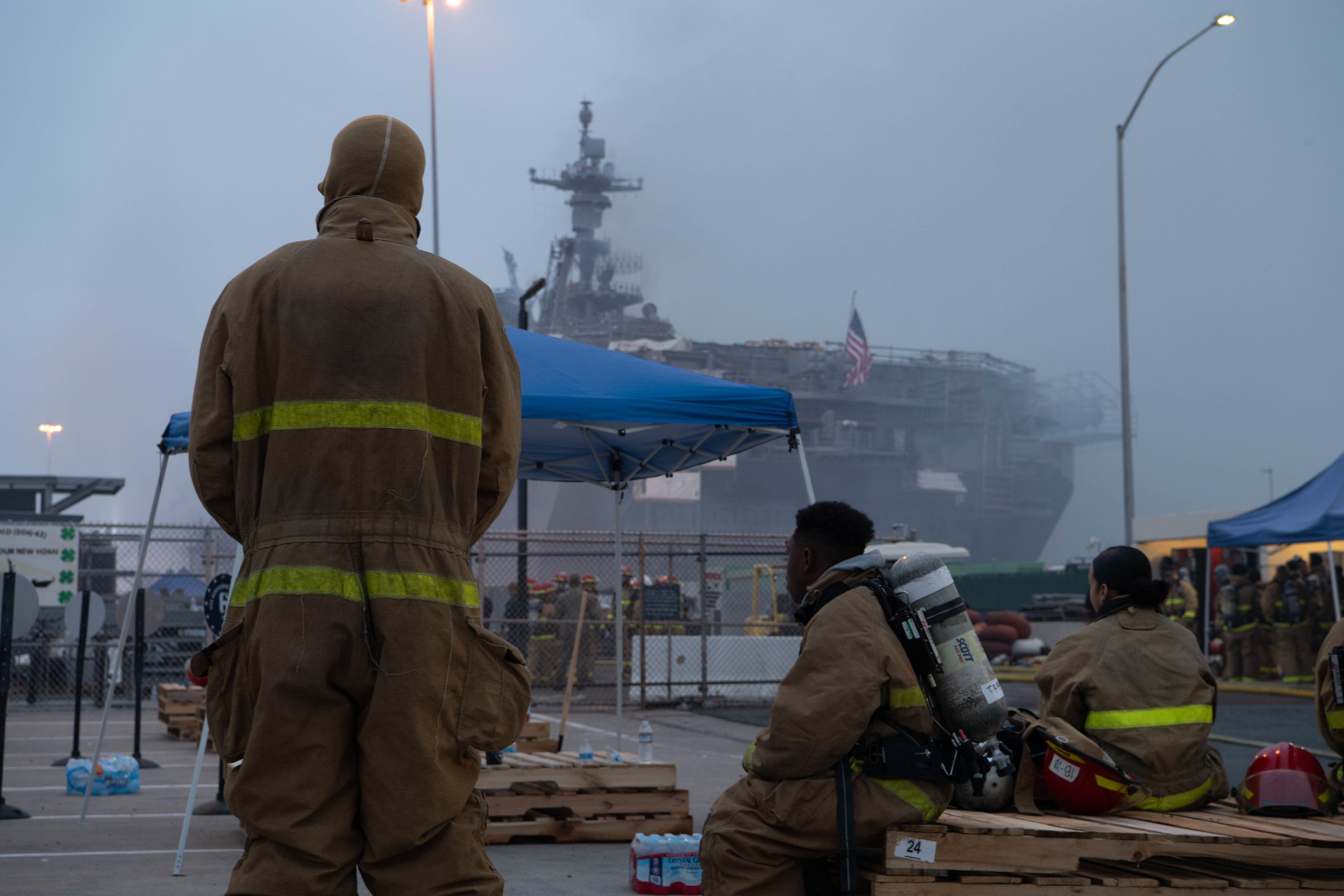
This post was updated with additional information from the Navy.
SAN DIEGO, Calif. — Navy and federal firefighting crews continued to battle fires inside USS Bonhomme Richard (LHD-6) Monday afternoon as Navy helicopters and boats poured water onto the ship for the second straight day to save the amphibious assault ship, despite ever-increasing reports of extensive damage.
“The superstructure and the upper decks continue to burn and sustain damage, and the forward mast has collapsed,” Rear Adm. Philip Sobeck, the Expeditionary Strike Group 3 commander, said during a Monday morning media briefing at the base, “and the ship is listing. However, dewatering is in progress.”
More than 400 sailors from various commands around the waterfront “are trying to save USS Bonhomme Richard,” said Sobeck, who took command of the San Diego-based expeditionary force in April.
As of 4 p.m. Monday local time, the five sailors who remained hospitalized overnight had been released, Naval Surface Force Pacific officials said in a statement. Two additional sailors were treated for minor injuries, bringing the total to 36 sailors and 23 civilians who officials said were treated for “minor” injuries, including smoke inhalation and heat exhaustion.

Only about 160 sailors of the ship’s 1,000 crew were aboard Bonhomme Richard when the fire broke out. The ship had been undergoing maintenance on Pier 2 at Naval Base San Diego, following a $249 million maintenance availability at the nearby General Dynamics NASSCO shipyard that included updates to support the Marine Corps’ advanced F-35B Lightning II joint strike fighter.
The fire, which was reported about 8:30 a.m. Monday, had escalated overnight and continued to spread even as the Navy deployed MH-60S helicopters with the “Merlins” of Helicopter Sea Combat Squadron 3 to drop water from the air and augment fire suppression efforts from federal and local water boats and firetrucks. A Navy photograph showed bright orange flames burning in the superstructure, engulfed by smoke on Monday evening.
“There’s obviously burn damage all the way through the skin of the ship,” Sobeck said, “and we are assessing that as we kind of go through each compartment to see exactly what the extent is.”
“The fire has spread throughout the ship in various stages, and so we are assessing the extent of the damage, and that’s going to be ongoing,” he said. “Once we get the fire out, which is a priority, we’ll then make a complete assessment on what we think are the damages.”
Crews were working to reach and battle various fires that continue to flash up throughout the ship, including one “closer to the bow, we’re trying to get that one as well,” he added. Adding to the difficulty, he noted, is the fact that Bonhomme Richard was undergoing a maintenance period, so lots of scaffolding and equipment to support that work were affixed to the ship and creates added debris that gets in the way and burns.
Initial suspicions point to a fire starting somewhere in the ship’s large stowage area in its lower decks, “Supplies were stored there, and that’s what I think ignited and started the fire,” Sobeck said Monday.
The initial reports of the fire “came from the crew members aboard. That’s how we know it was originated…in the lower V,” he added. “And as soon as we were made aware of it and reports made, then we started doing firefighting.”
No maintenance was being done in that area “to the best of our knowledge,” he said. “But there’s, obviously, that’s where we believe – at least that’s where it was reported as the source of the beginning of the fire.”
“So we’re going to do a full investigation to find out exactly what may have caused the fire,” he said, adding, “there’s different rags and all things that we use to maintain the ship and clean the ship, and make sure that we’re supporting the ship.”
Smoke and possible toxins from things like plastics and cables burning inside the ship, continue to spread, as smoke spews from the ship even as the firefighting efforts continue from Navy water-dropping helicopters in the air, fire boats on the water and fire trucks on the pier. “We’re checking everything that we know, and we’re within the EPA standards,” Sobeck said.

Efforts continued to put a “buffer” between the fires and about one million gallons of fuel in the ship’s storage tanks, Sobeck said. “Estimates right now is we’ve got at least two decks between the heat source and the fuel.”
Sobeck praised the efforts of the ship’s crew and sailors from other ships involved in the firefighting effort. “The response of the first action is based on the training that you just had,” Sobeck said, noting the training that sailors get from day one. “If there’s any sense about fire or danger, they will respond, react and make sure, again, the safety of self, ship and shipmate, and that’s exactly what they did.”
“During the initial stages (of the fire), it expanded beyond their capability. That’s when we called the San Diego Fire Department and Federal Fire, and they came in support,” Sobeck said. “By that time, it was already moving, and that’s when the explosion happened.”
“We had to reset, make sure they get the safety of shipmates. They did that, and we went back in and start fighting,” he added.
Two other ships on Pier 2, Arleigh Burke-class destroyers USS Russell (DDG-59) and USS Fitzgerald (DDG-62), were moved to different berthing on Sunday afternoon as the fire grew on the ship.
As the fire spread, local San Diego and nearby fire agencies sent firefighting trucks and equipment to the base to augment the initial efforts by the ship’s sailors and damage-control teams that typically respond to onboard emergencies.

The naval base has fire support from federal firefighters and also from San Diego Fire-Rescue Department, which responded to the initial three-alarm blaze and pulled back three hours later.
“We worked, at balanced team efforts, at where we bring the best skill set at the time,” Sobeck said at the briefing. “And they (SDFD) assessed that, again, they could be in support of Federal Fire,” Sobeck said. “Federal Fire took the lead role with the firefighting.”
“We go after and we plan for worst-case scenario all the time,” he added.
A day into fighting the fire aboard, sailors and firefighters inside the ship face a tough, hot environment, working through smoky spaces and damaged compartments.
“The fire, as it continues to go, you’ve got to assess stability within the compartments that you’re going through, understand the heat source. Temperatures are ranging as high as 1,000 degrees. You have to do it as a team effort – go in, assess, understand where you area – at the same time you’ve got a ship that is floating. You’ve got to weigh the balance of how much water is aboard ship, and make sure you’ve got a good balance there. So stability is a big issue.”
Local officials told CNN the fire could burn for several days.
“Today, we suffered a terrible tragedy aboard USS Bonhomme Richard (LHD-6) when a fire broke out aboard the ship while in port San Diego,” Chief of Naval Operations Adm. Mike Gilday said in a statement on Sunday.
“We are grateful for the quick and immediate response of local, base, and shipboard firefighters aboard USS Bonhomme Richard. Our thoughts and prayers are with our BHR Sailors, their families, and our emergency responders who continue to fight the fire. Godspeed.”
The big-deck amphib, commissioned in 1998, returned to San Diego in 2018 after being forward deployed to Japan for six years.





